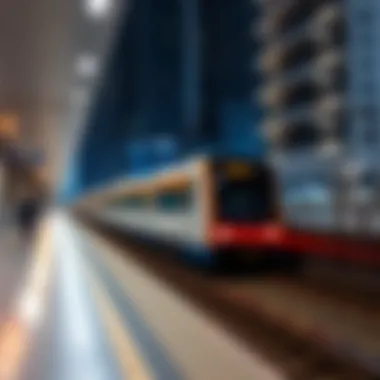Metro Timing Insights for Dubai's Real Estate Scene


Intro
Navigating the hustle and bustle of Dubai can often feel like an uphill battle. With a rapidly growing population and ambitious urban development, efficient public transportation has become essential. Among various transport options, the Dubai Metro stands out as a reliable and strategic system. Understanding the operational timing of the Metro extends beyond mere scheduling; it’s pivotal in shaping real estate dynamics in this vibrant city. In this guide, we will unpack how Metro timings influence accessibility, neighborhood desirability, and even property values. Investors and residents alike need this knowledge to make informed decisions in the ever-evolving Dubai real estate market.
Overview of Dubai Metro
The Dubai Metro stands as a cornerstone of public transport within the city. This intricate network of railways serves not just as a means of transit but also as a symbol of Dubai's urban evolution and ambition. Knowing about the Metro is essential for both residents and visitors alike. The rail system connects key districts, facilitating both convenience and efficiency while navigating the bustling metropolis.
Prolusion to Dubai Metro
The Dubai Metro first launched operations in September 2009 as the first fully automated and driverless metro line in the Gulf region. Covering approximately 75 kilometers, it connects points of interest across the city. The Metro comprises two main lines: the Red Line and the Green Line, which intermingle at selected interchange stations, ensuring smooth transfers for commuters.
The significance of the Metro extends beyond mere transport. For investors and homeowners, it plays a vital role in shaping real estate dynamics. Properties located near Metro stations often see higher market values, driven largely by the accessibility that public transport provides. This aspect of Metro service emphasizes that understanding the Metro’s operation can also inform one’s investment decisions in Dubai's evolving real estate landscape.
History and Development
The inception of the Dubai Metro wasn’t a mere whim but a calculated response to rising population and urbanization challenges. With an influx of residents and tourists, the city's roads became increasingly congested. The planning for the Metro began as early as 1996, with construction kicking off in 2006. The goal was clear: to create a reliable transportation option that could handle the rapid growth of the emirate.
Over the years, expansions of the Metro network saw new stations and updated technology, reflecting Dubai's overall progress. The added convenience of integrating real-time updates via mobile applications now allows commuters to plan their journeys more effectively, showcasing a blend of technology and infrastructure. This constant development proves that the Dubai Metro is not only a transportation solution but also a dynamic system that evolves alongside the city itself.
"A well-planned metro system can reshape an entire city’s landscape. In Dubai, it’s not just about getting from A to B; it’s about creating a coherent urban vision."
Dubai's commitment to public transportation has drawn acclaim on multiple fronts, including sustainability discussions. With metro options, the city aims to reduce carbon emissions and dependence on personal vehicles, echoing global trends towards eco-friendliness and smarter urban living. This facet of the Metro system connects directly with investors who prioritize sustainability in their real estate ventures.
Metro Timings and Schedule
Understanding the operational timings of the Dubai Metro is crucial for both daily commuters and potential investors. The metro serves as a backbone of public transport in a bustling city where time is of the essence. Defining a schedule allows for better planning not just for individuals, but also for businesses that rely on commuter flow. Knowing when the metro runs—and when it doesn't—helps in evaluating accessibility to various neighborhoods, and that indirectly influences property values, too.
Standard Operating Hours
The Dubai Metro typically operates from 5 am to midnight on weekdays, extending to 1 am on weekends. This provides ample time for commuters whether heading to work or enjoying the city’s vibrant nightlife. With this schedule, residents can rely on a reliable service to get to and fro without the hassle of traffic. In a city like Dubai, where commuting can often be a massive headache, the metro stands out as a beacon of convenience.
Key Operating Hours:
- Weekdays: 5:00 AM – 12:00 AM
- Weekends: 5:00 AM – 1:00 AM
This flexibility means that even for late-night events or early morning appointments, the metro can be counted on, making it an attractive aspect for housing developments near stations.
Weekend and Holiday Adjustments
On weekends and public holidays, the Metro extends its operational hours, making it particularly appealing for those who wish to explore the leisure offerings in Dubai. Adjustments to these timings are usually pre-announced, allowing for public awareness and planning ahead. It reflects a conscious effort to cater to the leisure needs of both residents and tourists, acknowledging that weekends are a prime time for outings.
Moreover, being aware of holiday adjustments can save commuters time and prevent the confusion that often accompanies different operational schedules.
"The seamless connectivity provided by the metro encourages both exploration and investment in surrounding areas, highlighting the symbiotic relationship between transportation and real estate."
Peak vs. Off-Peak Hours
Dubai's metro experience varies significantly between peak and off-peak hours. During peak times—typically 7-9 am and 5-8 pm on weekdays—the stations fill with commuters, making trips slightly less serene. The metro system is designed to accommodate this surge, with more frequent trains running during these hours. Knowing these peak times is invaluable for anyone looking to navigate the city efficiently.


Conversely, off-peak times, such as midday or late evenings, allow for a much quieter journey. This is particularly beneficial for those who prefer a more comfortable travel experience or for tourists who want to indulge in a leisurely sightseeing tour.
Point of Consideration:
- Commute during peaks for quicker access to critical areas but brace for crowds.
- Travel during off-peaks for a relaxed, ample-space environment.
In summary, the metro's operating schedule is a foundational element that influences not just individual journeys but also larger economic patterns linked to property investment and urban development. Awareness of how timings interplay with daily life and work can set the stage for informed decisions in both commuting and investment.
Impact of Timings on Commuters
Understanding the timings of the Dubai Metro holds significant weight for commuters, whether they are locals, expatriates, or tourists. The operational schedule influences how users navigate the city, planning their journeys effectively. Moreover, it plays a crucial role in shaping the overall user experience. Commuters often balance tight schedules, and every minute counts. Thus, the Metro's reliability and its operating hours significantly affect daily life and work productivity.
User Experience
The experience of commuting via the Metro in Dubai is directly tied to the operational hours. If the train services are frequent during peak hours, it provides a seamless transition for users rushing to get to work or attend appointments. The scheduled intervals—usually ranging from two to ten minutes depending on the time of day—allow commuters to make informed choices when timing their departures.
In addition to punctuality, the comfort level during various hours is something worth discussing. During peak times, which typically span morning and evening rush hours, trains can be bustling with passengers. As a result, the experience may be somewhat congested and overwhelming. On the other hand, during off-peak hours, the environment is usually more spacious and relaxed. Booking trips accordingly can thus enhance satisfaction levels.
Managing user expectations is crucial. Knowing the schedule can help residents set realistic travel plans while minimizing stress. Having access to real-time updates about train timings through apps or digital screens at the Metro stations can enhance the overall commuting experience.
“Well-timed transport is like a well-oiled machine - each cog performs its duty effortlessly.”
Accessibility for Residents
Timings directly affect how accessible the Metro is for residents across various neighborhoods. For those living in districts like Jumeirah or Al Barsha, the availability of Metro services plays a substantial role in daily commuting. Knowing that their nearest station operates consistently can boost confidence in using public transportation rather than driving or relying on taxis.
Furthermore, longer operating hours during weekends and holidays provide greater flexibility for residents wishing to explore or engage in leisure activities outside their immediate neighborhoods. This expanded accessibility can be a major factor when considering the quality of life in a community.
For families, the convenience of knowing the Metro's schedule aids in planning outings, such as trips to shopping malls or parks. It can serve as a cost-effective means of transport, liberating residents from the expenses tied to private vehicles. Consequently, easy access and reliable timings may lead to increased public transport usage, positively impacting traffic congestion and transportation sustainability.
In summary, understanding the Metro's timings not only influences how commuters feel about their travel experience but also affects the overall accessibility for residents. For both everyday travels and larger outings, the Metro serves as an integral part of life in Dubai, connecting communities and enhancing local experiences.
Neighborhoods Served by Metro
The Dubai Metro has become a backbone of public transportation in the city, not only simplifying daily commutes but also influencing the vibrancy of countless neighborhoods. Understanding which areas are accessible via the Metro can empower residents, investors, and homebuyers alike, providing significant insights into the urban tapestry of Dubai.
Among the primary benefits is how the Metro enhances connectivity. With stations strategically placed throughout the city, residents can travel with ease to various hotspots, be it for work or leisure. This accessibility encourages a more active lifestyle and can attract expatriates and tourists, all keen to bask in what Dubai has to offer.
Another key consideration is the rise in real estate appeal in neighborhoods near Metro stations. Properties close to these transit points often see an increase in demand. It's common knowledge that living close to public transport directly influences property values, making investments here potentially lucrative.
Additionally, as more neighborhoods become interconnected, there's potential for further developments. Areas previously seen as secondary due to poor transport links can experience revitalization, leading to modern residential offerings and amenities.
Key Districts and Their Accessibility
Dubai Metro serves several major districts, each with unique characteristics and accessibility features. Let's take a closer look:
- Dubai Marina: This vibrant district, known for its skyscrapers and waterfront lifestyle, is easily accessible via the metro, allowing seamless travel to work or social outings.
- Downtown Dubai: One of the most iconic areas, featuring the Burj Khalifa, is well-served by the metro, making it easy for visitors and residents to explore its cultural and shopping hubs.
- Deira: A historical area rich in culture and commerce, the commute to Deira via the metro is beneficial not only for residents but also for those working in local markets.
"Districts served by the Metro often showcase a blend of modernity and tradition, creating diverse pathways for community development."


The accessibility factor contributed by the Metro allows these districts to flourish, catering both to lifestyle seekers and business-minded individuals, resulting in a thriving environment.
Proximity to Real Estate Developments
Real estate developments often pulsate in tandem with local transportation infrastructure. Metro stations typically act as magnets for developers, prompting an increase in property projects nearby.
- Proximity Benefits: Living or investing in properties near Metro stations translates into convenience, as residents can avoid the headache of heavy traffic and parking challenges that are common in a bustling city like Dubai.
- Valued Locations: These areas not only provide easier access to various parts of Dubai but are often viewed as more desirable locations. Developers know that properties situated within walking distance of a metro station tend to fetch a premium, appealing to buyers who prioritize accessibility.
- Future Projects: With further stations planned, several evolving neighborhoods are positioning themselves as the next best places to live or invest in. Keeping an eye on these developments can give investors a head start into promising markets.
Real Estate Implications of Metro Timings
Understanding the timing of Dubai's Metro system holds pivotal significance, not only for commuters but also for the real estate market at large. This section unravels how the metro schedule intertwines with property values and the attitudes of potential buyers and investors. With public transport being a driving facet in shaping urban landscapes, the following subsections explore the nuanced relationship between Metro timings and real estate dynamics.
Impact on Property Values
The direct relationship between Metro timings and property values cannot be overstated. When accessibility to public transportation is high, properties in close proximity often see a surge in demand. The Dubai Metro operates on a commendably structured schedule, making life easier for both residents and businesses alike.
For instance, areas like Burj Khalifa and Jumeirah Lakes Towers enjoy premium property values, in large part due to their proximity to Metro stations. People are willing to pay top dirham to have that convenience at their doorstep. A home near a metro station is much more attractive, and many homebuyers don’t mind shelling out a few extra bucks for the daily ease it brings. Moreover, the strategic timings of the Metro, which operate both during peak and off-peak hours, allow residents to plan their commutes effectively. This efficiency is reflected in the rental prices and the overall value of properties nearby.
Additionally, the Metro's operational consistency ensures that not only housing prices but also commercial property values thrive. Businesses that rely on foot traffic benefit massively from proximity to Metro stations. The more frequently commuters can access a location via the Metro, the higher its foot traffic—and consequently its value.
"Residential properties near Metro lines witness a notable increase in demand, and this trend is proven to influence valuations over time."
Attractiveness for Investors and Buyers
The Metro system's timings create a ripple effect that pulls in not just residents, but also savvy investors. Those on the lookout for lucrative opportunities find value in properties along the Metro lines. Investors are increasingly aware of the significance of public transport, especially in a sprawling city like Dubai.
Properties situated near key Metro stations become prime targets for investment because they promise easy access to major business districts and leisure hotspots. For example, having a turnkey investment property near the Internet City or Media City stations can mean a steady stream of tenants—be it young professionals or expats drawn to the employment hubs.
Another appealing factor for buyers is the flexibility in commuting times offered by Metro's operational hours. With extended service times, potential residents can enjoy a more relaxed life, unbound by traditional rush hour constraints. They no longer face the headache of long commutes during peak hours, enhancing both the attractiveness and livability of the area.
Furthermore, real estate developers are keen to align their projects with the proximity of Metro stations. They recognize that new developments adjacent to Metro stations are more likely to catch the eyes of buyers. Thus, well-planned developments are sprouting up in tandem with forthcoming Metro expansions, particularly in emerging neighborhoods.
With all these factors in play, the integration of transit options is no longer a mere accessory; it’s becoming a central piece in influencing the decision-making process of property buyers and investors alike.
Future Developments in Metro Service
As the city of Dubai continues to evolve, so too does its public transit system. The future developments in the Dubai Metro are particularly vital from both a commuter's and investor's perspective. Enhanced services augment not just convenience for daily travelers but also play a pivotal role in shaping the urban landscape, influencing real estate trends, and fostering economic growth. By staying abreast of these developments, investors, homeowners, and expatriates can make informed decisions that align with their goals in this dynamic market.
Upcoming Station Openings
The Dubai Metro expansion plans are ambitious, with several new stations slated to open shortly. These developments are not just mere dots on a map; rather, they are gateways to increased accessibility and connectivity. For example, the eagerly awaited stations at Al Quoz and Dubai Marina aim to service high-density residential and commercial areas, making daily commutes smoother for thousands.
Some highlights of the upcoming station openings include:
- Al Quoz Industrial Area Station: This station is expected to connect workers with commercial jobs in the sprawling industrial zones.
- Dubai Marina Station: Positioned to serve one of the city’s most popular leisure and residential neighborhoods, it will attract both tourists and residents.
"The expansion of the metro brings not just convenience but also economic opportunities for neighborhoods nearby, enhancing their attractiveness for both investors and residents."
These stations promise to invigorate local businesses and uplift property values in their vicinity, making this information critical for anyone interested in the real estate market.


Enhancements to Existing Services
Beyond new stations, the ongoing enhancements to existing services represent a commitment to quality public transit. Various upgrades are on the horizon, including the implementation of smart technologies, which aim to optimize service efficiency and user satisfaction. For instance,
- Real-time Tracking: Passengers will enjoy live updates on train locations, minimizing waiting times and allowing better planning of journeys.
- Increased Train Frequency: During peak hours, the frequency of trains will be ramped up to handle the larger commuter volume, reducing crowding and improving the overall experience.
In addition, enhancements such as improved signage, accessibility features for people with disabilities, and better lighting across stations signify a focused effort to ensure that all users feel safe and welcome.
Investors should note that these improvements enhance the desirability of locations around existing metro stations, contributing positively to property values.
The future of Dubai's Metro is not only about mobility; it is also about fostering a more interconnected community, which will, in turn, strengthen the real estate market. As the phases of these developments roll out, staying well-informed will empower stakeholders to leverage opportunities effectively.
Considerations for Commuters
Navigating the bustling environment of Dubai can be a daunting task, especially when it comes to public transport. With the Dubai Metro as a backbone of the city’s transportation network, understanding its nuances is crucial for both residents and visitors. Recognizing the factors impacting the commuter experience not only informs users about practicality but also significantly enhances their journey. As one delves into considerations for commuters, several elements come to light that warrant a careful look.
Payment Systems and Pricing
One might consider how to pay for their journey on the Metro. The payment system in Dubai Metro is designed to be as user-friendly as possible, ensuring a smooth experience for all. Commuters utilize a Nol Card, which is essential for any traveler planning to use the Metro extensively.
- Types of Nol Cards: There are several types of Nol Cards available, including:
- Red Ticket: Ideal for occasional trips and can be loaded with a limited amount.
- Silver Card: Aimed for regular users, it offers more value and gives users discounted fares.
- Gold Card: For those seeking luxury, this allows access to first-class cabins at a premium price.
Prices fluctuate based on distance traveled and the card type. It's advisable to keep a few dirhams handy for initial purchases. Fares begin at around 3 AED, not exceeding 8 AED for longer journeys. This fare structure encourages both short and long-distance commuters alike, facilitating easy transfers and multiple stops along the way.
"The efficient payment system in Dubai Metro reduces hassle and supports seamless travel when urban navigation is essential."
Travel Tips for Efficient Use
While understanding payment systems is vital, efficient use of the Metro entails additional strategies. Here are several tips that can help commuters make the most of their journeys:
- Plan Ahead: Knowing peak hours can save both time and frustration. Generally, rushing hours occur between 7 to 9 AM and 5 to 7 PM, which can lead to crowded trains.
- Check the Schedule: Though the Metro operates regularly, it's wise to verify times in case of alterations or expanded holiday hours. Resources like the Dubai Roads and Transport Authority's website provides up-to-date information.
- Boarding Strategy: If you're looking to avoid crowded trains, boarding the train from the rear or using the first cabin can be beneficial.
- Use the Metro App: The official Dubai Metro app not only helps keep track of fares and navigate routes, but also alerts users to service disruptions, adding another layer of convenience.
- Mind the Etiquette: Always give priority to those exiting, and be mindful of designated areas for the elderly and those with disabilities. This consideration enhances the travel experience for everyone.
End
The conclusion serves as the backbone of this article, stitching together all the insights drawn from exploring Dubai Metro's operational timings. Understanding the nuances of Metro timings is not just academic; it holds practical significance for residents, investors, and potential buyers alike. The manner in which the Metro functions directly affects daily commutes, property values, and even lifestyle choices in the bustling city of Dubai.
In recapping our discussion, we highlight the following essential elements:
- Metro’s Extensive Reach: The network's coverage contributes to its role as a primary transport option for thousands of commuters.
- Adaptive Scheduling: Understanding weekend and holiday adjustments allows better planning for both leisure and business trips.
- Peak vs. Off-Peak Impact: Insight into crowded hours empowers users to make smart travel choices, optimizing their time spent.
For investors and homeowners, recognizing how Metro accessibility influences property values is crucial. Areas with close proximity to stations might witness escalating demand, thereby providing a ripe opportunity for investment. Equally important is the effect this transportation system has on daily life. Residents benefit from easier navigation across the city, making it a more attractive locale for expats and local families alike.
In short, the timing of the Dubai Metro is a critical element entwined with the city's pulse, significantly shaping the practical and economic landscape.
Summary of Key Points
- Operational Schedule: The Dubai Metro operates with varied timings throughout the week, accommodating both early risers and night owls.
- Weekend Variability: Adjustments in the scheduling during weekends and holidays cater to the unique patterns of leisure and travel.
- Peak Hours: Awareness of peak hours helps commuters plan effectively, mitigating the stress that comes from crowded travel.
- Residential Accessibility: Metro stations are integral to the accessibility of various neighborhoods, enhancing the living experience.
- Investment Potential: Knowledge of how Metro timings can impact property values presents a strategic advantage for real estate stakeholders.
Final Thoughts on Metro's Role in Dubai
The Dubai Metro stands as a remarkable feat of urban transportation, serving not only as a lifeline for daily commuters but also as a catalyst for economic growth and urban development. As this system continues to evolve, its influence is likely to deepen, intertwining itself more intricately with the fabric of Dubai.
For investors, the timing of the Metro is akin to a compass; it guides decisions on where to invest or where to establish businesses. Homeowners and residents benefit from the convenience it offers, transforming what once may have been lengthy commutes into affordable and reliable journeys. Understanding these dynamics is essential for anyone looking to navigate the expanse of Dubai’s developmental landscape.







